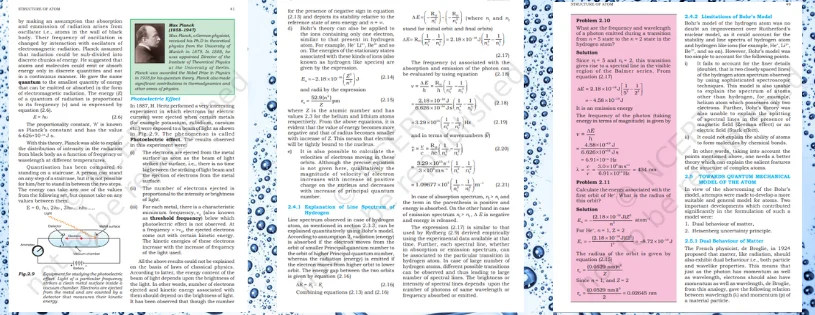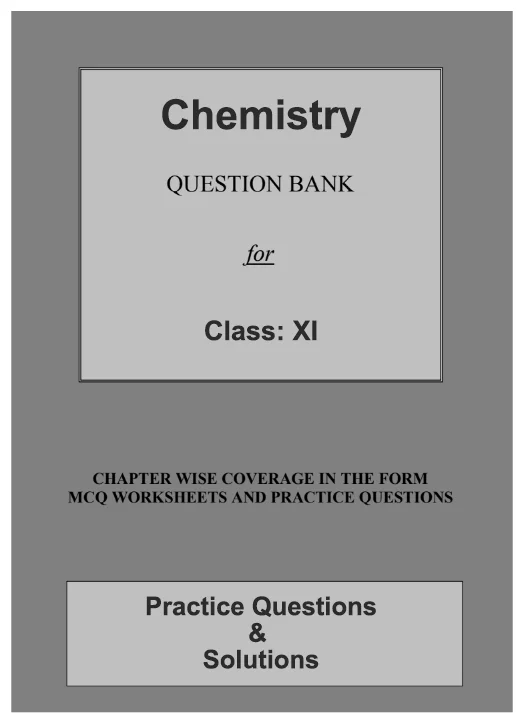In the early 20th century, the enigma of the hydrogen atom's structure perplexed scientists. Enter Niels Bohr, whose groundbreaking model, proposed in 1913, transformed our understanding of atomic architecture. Bohr's model introduced the concept of quantized orbits and explained the spectral lines of hydrogen, offering a quantum leap in atomic theory. Join us on a journey to unravel the mysteries of Bohr's model, where electrons dance in fixed paths around the nucleus, energy is quantized, and the seeds of modern quantum mechanics are sown. Explore the elegance and significance of Bohr's revolutionary insights into the heart of the simplest atom.
Decoding Bohr's Model of Hydrogen in CBSE NCERT Download
Bohr's Model of the Hydrogen Atom
The Bohr Model of the Hydrogen Atom, proposed by Danish physicist Niels Bohr in 1913, marked a significant advancement in the understanding of atomic structure. Here are the key features of Bohr's model as applied to the hydrogen atom:
- Quantized Orbits: Bohr proposed that electrons orbit the hydrogen nucleus in quantized, circular orbits at fixed distances. Each orbit represents a specific energy level.
- Energy Levels: Electrons in Bohr's model can exist only in certain discrete energy levels. The closer an electron is to the nucleus, the lower its energy level.
- Angular Momentum Quantization: Bohr introduced the concept of quantized angular momentum, stating that an electron's angular momentum is an integer multiple of h/2π (Planck's constant divided by 2π).
- Stability of Orbits: Bohr's model addressed the classical physics problem of electrons continuously losing energy and spiraling into the nucleus. Electrons in stable orbits do not radiate energy, maintaining their stability.
- Energy Absorption and Emission: Electrons absorb energy to move to higher energy levels and emit energy when transitioning to lower levels. The emitted or absorbed energy corresponds to the difference in energy levels, explaining the observed spectral lines.
- Bohr Radius: The distance from the electron to the nucleus in the lowest energy orbit is called the Bohr radius, denoted as 'a₀.'
- Hydrogen Emission Spectrum: Bohr's model successfully explained the discrete lines in the hydrogen emission spectrum, providing a theoretical framework for understanding spectral observations.
While Bohr's model was groundbreaking, it had limitations and was later surpassed by quantum mechanics. Despite its eventual evolution, Bohr's model remains a crucial historical step in the development of atomic theory.
What is Bohr’s Atomic Model?
According to Bohr, electrons travel in circular paths around the nucleus, and these orbits are restricted to specific, quantized distances from the nucleus. Each orbit corresponds to an energy level, and electrons can absorb or emit energy only in discrete amounts when transitioning between these levels. Bohr also quantized the angular momentum of electrons, stating it is an integer multiple of Planck's constant divided by 2π.
One key innovation was Bohr's explanation of the hydrogen emission spectrum. The model successfully accounted for the observed discrete spectral lines by linking them to specific electron transitions between energy levels. Additionally, Bohr introduced the idea that electrons in stable orbits do not radiate energy, addressing a flaw in classical physics.

Postulates of Bohr’s hydrogen atom
Bohr's hydrogen atom model, proposed in 1913, featured quantized electron orbits, each corresponding to a specific energy level. Electrons transition between these orbits, emitting or absorbing energy in discrete packets. Angular momentum is quantized, adhering to an integer multiple of Planck's constant divided by 2π. Stable orbits don't radiate energy. The model successfully explained hydrogen's spectral lines. The Bohr radius defines the distance between the electron and nucleus in the lowest energy orbit. While revolutionary, Bohr's model is limited to hydrogen-like atoms and its postulates were later refined by quantum mechanics for a more comprehensive understanding of atomic structure.
CBSE Class 11th Downloadable Resources:
|
1. CBSE Class 11th Topic Wise Summary |
View Page / Download |
|
2. CBSE Class 11th NCERT Books |
View Page / Download |
|
3. CBSE Class 11th NCERT Solutions |
View Page / Download |
|
4. CBSE Class 11th Exemplar |
View Page / Download |
|
5. CBSE Class 11th Sample Papers |
View Page / Download |
|
6. CBSE Class 11th Question Bank |
View Page / Download |
|
7. CBSE Class 11th Topic Wise Revision Notes |
View Page / Download |
|
8. CBSE Class 11th Last Minutes Preparation Resources |
View Page / Download |
|
9. CBSE Class 11th Best Reference Books |
View Page / Download |
|
10. CBSE Class 11th Formula Booklet |
View Page / Download |
Being in CBSE class 11th and considering the board examinations you must be needing resources to excel in your examinations. At TestprepKart we take great pride in providing CBSE class 11th all study resources in downloadable form for you to keep you going.
Below is the list of all CBSE class 11th Downloads available on TestprepKart for both Indian and NRI students preparing for CBSE class 11th in UAE, Oman, Qatar, Kuwait & Bahrain.
SAMPLE PRACTICE QUESTIONS OF SIGNIFICANT FIGURES:
Q1.Why was Bohr's model necessary for the hydrogen atom?
Answer. Bohr's model was developed to address the limitations of classical physics and explain the observed discrete spectral lines in the hydrogen emission spectrum, providing a more accurate depiction of atomic structure.
Q2. What are quantized orbits in Bohr's model?
Answer. In Bohr's model, quantized orbits refer to the specific, fixed paths that electrons take around the nucleus. These orbits are restricted to discrete distances from the nucleus, corresponding to specific energy levels.
Q3.What is the Bohr radius in the hydrogen atom?
Answer. The Bohr radius is the average distance between the electron and the nucleus in the lowest energy orbit of a hydrogen atom in Bohr's model.
Q4. How did Bohr's model contribute to the development of atomic theory?
Answer. Bohr's model played a crucial role in advancing atomic theory by introducing the concept of quantized energy levels and explaining the hydrogen spectrum. It served as a transitional model, paving the way for the more comprehensive principles of quantum mechanics.
Q5. Did Bohr's model have any limitations?
Answer. Bohr's model had limitations, especially when applied to atoms with more than one electron. It couldn't fully account for the complexities of multi-electron systems and was eventually succeeded by more advanced quantum mechanical models.
| CBSE CLASS 11th Chemistry Chapters |
| Chapter1: SOME BASIC CONCEPTS OF CHEMISTRY |
| Chapter2: STRUCTURE OF ATOMS |
| > Discovery of Sub-Atomic Particle |
| > Atomic Models |
| > Developments Leading to the Bohr’s Model of Atom |
| > Towards Quantum Mechanical Model of the Atom |
| > Quantum Mechanical Model of Atom |
| Chapter3: CLASSIFICATION OF ELEMENTS AND PERIODICITY IN PROPERTIES |
| Chapter4: CHEMICAL BONDING AND MOLECULAR STRUCTURE |
| Chapter5: THERMODYNAMICS |
| Chapter6: EQUILIBRIUM |
| Chapter7: REDOX REACTIONS |
| Chapter8: ORGANIC CHEMISTRY – SOME BASIC PRINCIPLE AND TECHNIQUES |
| Chapter9: Hydrocarbons HYDROCARBONS |
| CBSE Class 11 Physics Chapters |
| Chapter1: UNITS AND MEASUREMENTS |
| Chapter2: MOTION IN A STRAIGHT LINE |
| Chapter3: MOTION IN A PLANE |
| Chapter4: LAWS OF MOTION |
| Chapter5: WORK, ENERGY AND POWER |
| Chapter6: SYSTEM OF PARTICLES AND ROTATIONAL MOTION |
| Chapter7: GRAVITATION |
| Chapter8: MECHANICAL PROPERTIES OF SOLIDS |
| Chapter9: MECHANICAL PROPERTIES OF FLUIDS |
| Chapter10: THERMAL PROPERTIES OF MATTER |
| Chapter12: KINETIC THEORY |
| Chapter13: OSCILLATIONS |
| Chapter14: WAVES |
| CBSE Class 11 Mathematics chapter |
| Chapter1: SETS |
| Chapter2: RELATIONS AND FUNCTIONS |
| Chapter3: TRIGONOMETRIC FUNCTIONS |
| Chapter4: COMPLEX NUMBER AND QUADRATIC EQUATIONS |
| Chapter5: LINEAR INEQUALITIES |
| Chapter6: PERMUTATIONS AND COMBINATIONS |
| Chapter7: BINOMIAL THEOREM |
| Chapter8: SEQUENCES AND SERIES |
| Chapter9: STRAIGHT LINES |
| Chapter10: CONIC SECTIONS |
| Chapter11: INTRODUCTION TO THREE-DIMENSIONAL GEOMETRY |
| Chapter12: LIMITS AND DERIVATIVES |
| Chapter13: STATISTICS |
| Chapter14: PROBABILITY |
| Class 8 Link soon |
| Class 9 Link soon |
| Class 10 Link soon |
| Class 12 Link soon |

Leave a Reply